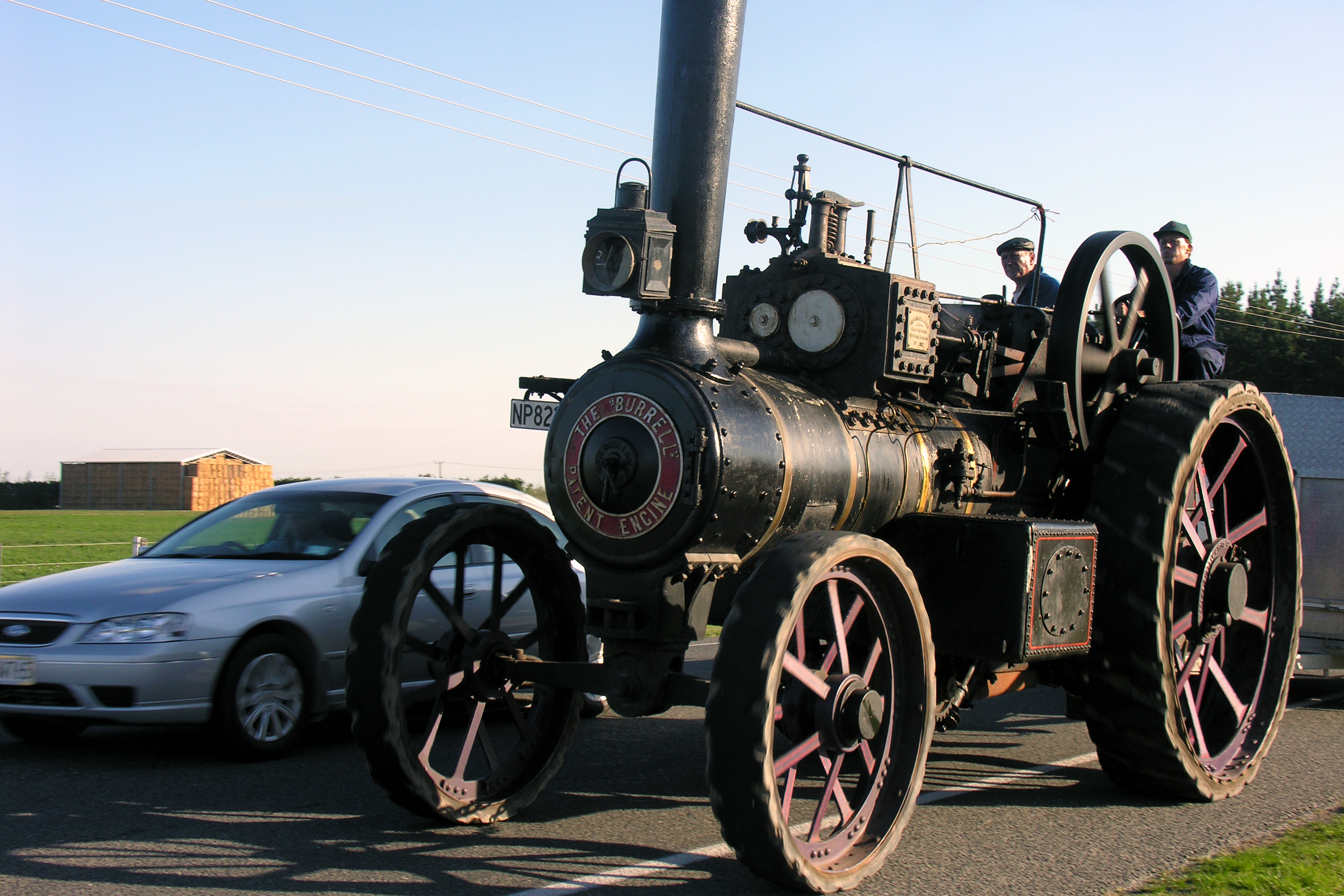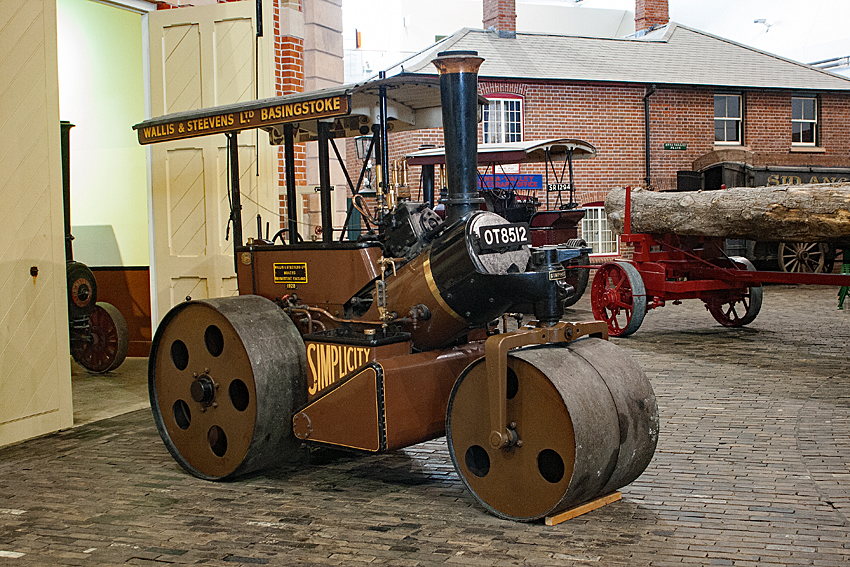|
Strumpshaw Hall Steam Museum
The Strumpshaw Hall Steam Museum in Strumpshaw, Norfolk is home to a collection of Traction engines, Steam rollers, a Showman's engine and a Steam wagon which are run on special occasions and on the last Sunday of each month from April to October. The Hall itself is GradeII listed, and in the grounds are a touring caravan site. Neighbouring the hall and farm estate is the Strumpshaw Fen RSPB reserve. Strumpshaw Hall The existing house was built in 1835 by Thomas Tuck. The two storey property is built of red brick on a rendered base, featuring three bays enclosing sash windows, topped by a hipped slate roof and two chimneys. Within the central bay, extended by a pediment, it features a Doric porch. The main house was added to in the Victorian era with a lower two-storey service wing, which is three windows wide. It was listed GradeII in 1979. History The collection was started privately by Wesley Key, and his family still own the hall, grounds and most of the exhibits. Key eventu ... [...More Info...] [...Related Items...] OR: [Wikipedia] [Google] [Baidu] |
Strumpshaw
Strumpshaw is a village and civil parish in the English county of Norfolk. It is located on the northern bank of the River Yare around south-east of Norwich. The parish covers an area of and had a population of 602 in 245 households at the 2001 census, . Office for National Statistics & Norfolk County Council (2001). Retrieved 20 June 2009. increasing to a population of 634 in 261 households at the 2011 Census. For the purposes of local government, it falls within the of |
Charles Burrell & Sons
Charles Burrell & Sons were builders of steam traction engines, agricultural machinery, steam lorries and steam tram engines. The company were based in Thetford, Norfolk and operated from the St Nicholas works on Minstergate and St Nicholas Street, some of which survives today. At their height they employed over 350 people and were the largest employer within the town. The company became known for producing reliable and good-looking traction engines which were always built to customers' requirements. The company declined after the First World War when internal combustion engines started to become a cheaper alternative to steam power. The company finally closed in 1928, with the final engines being built by Richard Garrett & Sons at Leiston, Suffolk. History 1770 to 1847: Early years In 1770 a Joseph Burrell, a master smith, established a small forge in Thetford, for the manufacture and repair of agricultural implements. Lane (1971), p. 23 In 1801 a Joseph Burrell was found t ... [...More Info...] [...Related Items...] OR: [Wikipedia] [Google] [Baidu] |
Beam Engine
A beam engine is a type of steam engine where a pivoted overhead beam is used to apply the force from a vertical piston to a vertical connecting rod. This configuration, with the engine directly driving a pump, was first used by Thomas Newcomen around 1705 to remove water from mines in Cornwall. The efficiency of the engines was improved by engineers including James Watt, who added a separate condenser; Jonathan Hornblower and Arthur Woolf, who compounded the cylinders; and William McNaught, who devised a method of compounding an existing engine. Beam engines were first used to pump water out of mines or into canals but could be used to pump water to supplement the flow for a waterwheel powering a mill. The rotative beam engine is a later design of beam engine where the connecting rod drives a flywheel by means of a crank (or, historically, by means of a sun and planet gear). These beam engines could be used to directly power the line-shafting in a mill. They also c ... [...More Info...] [...Related Items...] OR: [Wikipedia] [Google] [Baidu] |
Robey & Co
Robey and Co. was an engineering company based in Lincoln, England which can be traced back to at least 1849. In 1854 Watkinson and Robey ''Engineers and Millwrights'' were manufacturing Portable Engines and machinery of every description in Rumbold Street, Lincoln. They were joined by George Lamb Scott, but in 1855 Watkinson, who had previously worked for Clayton & Shuttleworth of Lincoln, left the company. The business then became Robey and Scott and moved their premises by 1856 to Canwick Road, Lincoln. Another partner, Thomas Gamble, joined the firm and Scott resigned in September 1856 to found his own manufacturing company in Manchester. The company then became Gamble & Robey, but by 1868 was known as Robey & Co Ltd. Robert Robey died in 1876 and the firm continued as a partnership led by John Richardson. In 1893 Robey & Co became a limited company. By 1913 Robeys were makers of steam motor wagons, tractors and ploughs and in the First World War manufactured aircraft. T ... [...More Info...] [...Related Items...] OR: [Wikipedia] [Google] [Baidu] |
International Harvester
The International Harvester Company (often abbreviated by IHC, IH, or simply International ( colloq.)) was an American manufacturer of agricultural and construction equipment, automobiles, commercial trucks, lawn and garden products, household equipment, and more. It was formed from the 1902 merger of McCormick Harvesting Machine Company and Deering Harvester Company and three smaller manufactures: Milwaukee; Plano; and Warder, Bushnell, and Glessner (manufacturers of Champion brand). In the 1980s all divisions were sold off except for International Trucks, which changed its parent company name to Navistar International (NYSE: NAV). Its brands included McCormick, Deering, and later McCormick-Deering, as well as International. Along with the Farmall and Cub Cadet tractors, International was also known for the Scout and Travelall vehicle nameplates. Given its monumental importance to the building of rural communities the brand continues to have a massive cult following. The ... [...More Info...] [...Related Items...] OR: [Wikipedia] [Google] [Baidu] |
Field Marshall
Field-Marshall was a brand of farm tractor which was manufactured by Marshall, Sons & Co. of Gainsborough, Lincolnshire in the United Kingdom. Field-Marshalls were in production from 1945 to 1957. However, the first single-cylinder Marshall came into production in 1930. Earlier Marshall tractor line The first single-cylinder Marshall tractor to be introduced was the Marshall 15/30 in 1930. It had a bore with a stroke (= 8.237 litres) and the maximum speed was 550 r.p.m., or 9.1666 revolutions per second. In 1932 the 15/30 was upgraded to become the Marshall 18/30. This model featured the same bore and stroke dimensions but the maximum r.p.m. was increased and the tractor's transmission was heavily modified. The next single-cylinder Marshall to be introduced was the Marshall 12/20 in 1935. This tractor was of a completely new design, with a -inch bore and a stroke (= 4.17 litres). There were many smaller modifications such as a redesigned injection pump and cylinder head. ... [...More Info...] [...Related Items...] OR: [Wikipedia] [Google] [Baidu] |
Wallis & Steevens
Wallis & Steevens of Basingstoke, Hampshire, England produced agricultural equipment, traction engines and steam and diesel road rollers. History The company was founded in 1856 by Arthur Wallis and Charles Haslam in newly built premises which they named ''The North Hants Ironworks''. The works were sited on Station Hill in Basingstoke and the company began trading as ''Wallis & Haslam''. Shortly afterwards the company was highly commended for its hand-worked bench drilling machine at the 1857 Royal Agricultural show in Salisbury. Even at this early stage, the company was producing a wide variety of agricultural equipment, and alongside the bench drill were corn drills, turnip drills, four types of horse hoe, drag harrows, a 3 hp threshing machine, a barley hummeller and sundry other devices. In 1862 a third partner, Charles James Steevens, joined the company and when Charles Haslam retired in 1869 the company became ''Wallis & Steevens''. The date of production for the ... [...More Info...] [...Related Items...] OR: [Wikipedia] [Google] [Baidu] |
Ruston & Hornsby
Ruston & Hornsby was an industrial equipment manufacturer in Lincoln, Lincolnshire, Lincoln, England founded in 1918. The company is best known as a manufacturer of narrow gauge railway, narrow and standard gauge diesel locomotives and also of steam shovels. Other products included automobile, cars, steam locomotives and a range of internal combustion engines, and later gas turbines. It is now a subsidiary of Siemens. Background Proctor & Burton was established in 1840, operating as millwrights and engineers. It became Ruston, Proctor and Company in 1857 when Joseph Ruston joined them, acquiring limited liability status in 1899. From 1866 it built a number of four and six-coupled tank locomotives, one of which was sent to the Exposition Universelle (1867), Paris Exhibition in 1867. In 1868 it built five 0-6-0 tank engines for the Great Eastern Railway to the design of Samuel Waite Johnson. Three of these were converted to crane tanks, two of which lasted until 1952, aged eighty ... [...More Info...] [...Related Items...] OR: [Wikipedia] [Google] [Baidu] |
Portable Engine
A portable engine is an engine, either a steam engine or an internal combustion engine, that sits in one place while operating (providing power to machinery), but (unlike a stationary engine) is wikt:portable#Adjective, portable and thus can be easily moved from one work site to another. Mounted on wheels or skids, it is either towed to the work site or moves there via self-propulsion. Portable engines were in common use in industrialised countries from the early 19th through early 20th centuries, during an era when power transmission#Mechanical power, mechanical power transmission was widespread. Before that, most power generation and transmission were by working animal, animal, watermill, water, windmill, wind, or manual labour, human; after that, a combination of electrification (including rural electrification) and modern vehicles and equipment (such as tractors, trucks, automobile, cars, engine-generators, and machines with their engines built in) displaced most use of porta ... [...More Info...] [...Related Items...] OR: [Wikipedia] [Google] [Baidu] |
Ransomes, Sims & Jefferies
Ransomes, Sims and Jefferies Limited was a major British agricultural machinery maker also producing a wide range of general engineering products in Ipswich, Suffolk including traction engines, trolleybuses, ploughs, lawn mowers, combine harvesters and other tilling equipment. Ransomes also manufactured Direct Current electric motors in a wide range of sizes, and electric forklift trucks and tractors. They manufactured aeroplanes during the First World War. Their base, specially set up in 1845, was named Orwell Works. Ransomes' railway equipment business was hived off in 1869 with a different ownership as Ransomes & Rapier and based nearby at Waterside Ironworks. History 18th century The enterprise was started by Robert Ransome (1753–1830), who was born into a Quaker family in Norfolk, and became an apprentice to an ironmonger in Norwich. The Quaker values of frugal living, avoiding debt and keeping regular accounts served him well when he set up one of the first brass and ... [...More Info...] [...Related Items...] OR: [Wikipedia] [Google] [Baidu] |
Richard Garrett & Sons
Richard Garrett & Sons was a manufacturer of agricultural machinery, steam engines and trolleybuses. Their factory was Leiston Works, in Leiston, Suffolk, England. The company was founded by Richard Garrett in 1778. The company was active under its original ownership between 1778 and 1932. In the late 1840s, after cultivating a successful agricultural machine and implement business, the company began producing portable steam engines. The company grew to a major business employing around 2,500 people. Richard Garrett III, grandson of the company's founder, visited the Great Exhibition in London in 1851, where he saw some new American manufacturing ideas. Richard Garrett III introduced flow line production – a very early assembly line - and constructed a new workshop for the purpose in 1852. This was known as 'The Long Shop' on account of its length. A machine would start at one end of the Long Shop and as it progressed through the building it would stop at various sta ... [...More Info...] [...Related Items...] OR: [Wikipedia] [Google] [Baidu] |


.jpg)


.jpg)

